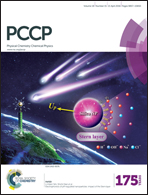Palladium-atom catalyzed formic acid decomposition and the switch of reaction mechanism with temperature†
Abstract
Formic acid decomposition (FAD) reaction has been an innovative way for hydrogen energy. Noble metal catalysts, especially palladium-containing nanoparticles, supported or unsupported, perform well in this reaction. Herein, we considered the simplest model, wherein one Pd atom is used as the FAD catalyst. With high-level theoretical calculations of CCSD(T)/CBS quality, we investigated all possible FAD pathways. The results show that FAD catalyzed by one Pd atom follows a different mechanism compared with that catalyzed by surfaces or larger clusters. At the initial stage of the reaction, FAD follows a dehydration route and is quickly poisoned by CO due to the formation of very stable PdCO. PdCO then becomes the actual catalyst for FAD at temperatures approximately below 1050 K. Beyond 1050 K, there is a switch of catalyst from PdCO to Pd atom. The results also show that dehydration is always favoured over dehydrogenation on either the Pd-atom or PdCO catalyst. On the Pd-atom catalyst, neither dehydrogenation nor dehydration follows the formate mechanism. In contrast, on the PdCO catalyst, dehydrogenation follows the formate mechanism, whereas dehydration does not. We also systematically investigated the performance of 24 density functional theory methods. We found that the performance of the double hybrid mPW2PLYP functional is the best, followed by the B3LYP, B3PW91, N12SX, M11, and B2PLYP functionals.


 Please wait while we load your content...
Please wait while we load your content...